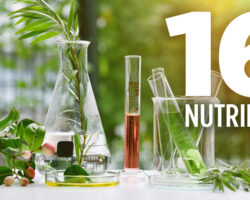
Get to Know Your Plants
From Chapter 12 of "Healthy Garden Healthy You" by Milo Shammas
Plant Benefits to Humans and Other Life
From their beginnings as microscopic, single-cell organisms, plants have been linked to all life on earth. Plants form the biosphere, a thin shell covering the earth's surface where plants and animals exist. Our reliance on plants has helped humans evolve from primitive surroundings to modern, sophisticated civilizations. Our ability to pass knowledge from generation to generation has taken us out of the primitive, hand-to-mouth existence of the early hominids and accelerated us into prosperous and progressive people. The ability to create art and express our early thoughts of survival, agricultural findings, mathematical equations and scientific data on paper made from plants has given us a progression of knowledge across many generations. Plants are the raw material of much of our created world (clothing, homes, furniture and medicines plus much more) and are essential for survival and the quality of life for all mankind.
Plants clean the air; they exchange the oxygen we breathe for the carbon dioxide we exhale. They use the energy of the sun to make foods that sustain all animals. From the soil, they draw micronutrients, minerals, nitrogen, phosphors, potassium, calcium and iron that are crucial for our existence and health. Plants absorb many of their nutrients from the atmosphere, water and soil in the form of gases, such as carbon, hydrogen and oxygen.
Roots are not the only way plants get the nutrients they rely on. They also absorb carbon dioxide through their leaves to help cleanse the environment. Sunlight energy creates sugars such as sucrose, fructose and glucose through the process called photosynthesis. Plants also absorb nitrogen gas that has been fixed from the atmosphere. Nearly 80 percent of the air we breathe is nitrogen gas. Nitrogen is essential for protein synthesis in plants, because it is a main constituent of the molecules of most amino acids that form into proteins.
Plants have thousands of microscopic openings located on every leaf for absorbing carbon dioxide and water laden with nutrients. They absorb these gases and liquids through pores in their leaves called stomata. (The word comes from the Greek word stoma, which means mouth.) Stomata are found mainly on the underside of the leaves. What they absorb they transport where needed within the plant itself. The stomata close up during the night (when no photosynthesis occurs), on hot days when plants might lose too much water and dry up, or when wind threatens to dry the plant.
How Plants Function
Plants grow in proportion to the amount of light, water, minerals and oxygen they receive. Genes determine a plant's lifespan; one year for annuals, two for biennials and indefinitely for perennials. (If you ever notice the term indeterminate used on tomato plants, it means the plant will continue to grow until environmental conditions become a limiting factor.)
When it receives plenty of fertilizer, careful watering, optimum sun energy and thinning (removing plants that compete for available nutrients and light) a plant can be pushed to its limits of leaf and flower production.
The plants we grow for food and flowers remain anchored in one place throughout their life. Soil buries half of a plant's body, the root system. This hidden half of the plant is where nature's magic happens. Above-ground shoot systems (stems and leaves) occupy a bright, sunlit and airy world. This is where the other half of the growth occurs. Roots and shoots grow in opposite directions, but each part has a role to contribute to the song of life. Root growth and shoot growth are brilliantly coordinated and complement each other, with energy reserves and raw materials shared equally by the two halves. When daily or seasonal environmental changes affect one part, the other must respond to support its "other half." A plant can only fulfill its fundamental basics of life, such as reproduction, cellular metabolism and growth, through the precisely controlled interactions between roots, stems, leaves and flowers. This is the bright, beautiful, harmonious song of plant life in full bloom across the earth.
A plant's ability to multiply and grow while we busily lead our lives seems magical and amazing. At the right time of year, you can leave a tomato garden over a three-day weekend and when you return all the tomatoes that were small and green on the vine have become a beautiful, healthy, robust red harvest of produce for you. All this happened while you were busy living your life. We need plants more than they need us. We should feed them and nurture them to the best of our ability as they do for us when we consume them.
Milo Lou Shammas
Founder and Formulator





